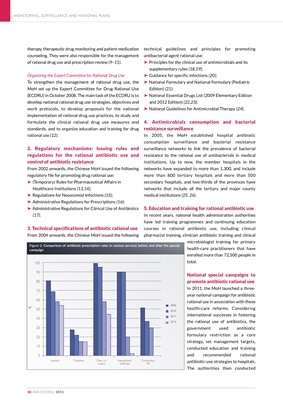
technical guidelines and principles for promoting
antibacterial agent rational use:
‰ Principles for the clinical use of antimicrobials and its
supplementary rules (18,19);
‰ Guidance for specific infections (20);
‰ National Formulary and National Formulary (Pediatric
Edition) (21);
‰ National Essential Drugs List (2009 Elementary Edition
and 2012 Edition) (22,23);
‰ National Guidelines for Antimicrobial Therapy (24).
4. Antimicrobials consumption and bacterial
resistance surveillance
In 2005, the MoH established hospital antibiotic
consumption surveillance and bacterial resistance
surveillance networks to link the prevalence of bacterial
resistance to the rational use of antibacterials in medical
institutions. Up to now, the member hospitals in the
networks have expanded to more than 1,300, and include
more than 800 tertiary hospitals and more than 500
secondary hospitals, and two-thirds of the provinces have
networks that include all the tertiary and major county
medical institutions (25, 26).
5. Education and training for rational antibiotic use
In recent years, national health administration authorities
have led training programmes and continuing education
courses in rational antibiotic use, including clinical
pharmacist training, clinician antibiotic training and clinical
microbiologist training for primary
health-care practitioners that have
enrolled more than 72,500 people in
total.
National special campaigns to
promote antibiotic rational use
In 2011, the MoH launched a threeyear
national campaign for antibiotic
rational use in association with these
health-care reforms. Considering
international successes in fostering
the rational use of antibiotics, the
government used antibiotic
formulary restriction as a core
strategy, set management targets,
conducted education and training
and recommended rational
antibiotic-use strategies to hospitals.
The authorities then conducted
MONITORING, SURVEILLANCE AND NATIONAL PLANS
50 AMR CONTROL 2015
therapy, therapeutic drug monitoring and patient medication
counseling. They were also responsible for the management
of rational drug use and prescription review (9-11).
Organizing the Expert Committee for Rational Drug Use
To strengthen the management of rational drug use, the
MoH set up the Expert Committee for Drug Rational Use
(ECDRU) in October 2008. The main task of the ECDRU is to
develop national rational drug use strategies, objectives and
work protocols, to develop proposals for the national
implementation of rational drug use practices, to study and
formulate the clinical rational drug use measures and
standards, and to organize education and training for drug
rational use (12).
2. Regulatory mechanisms: Issuing rules and
regulations for the rational antibiotic use and
control of antibiotic resistance
From 2002 onwards, the Chinese MoH issued the following
regulatory file for promoting drug rational use:
‰ (Temporary) Rules for Pharmaceutical Affairs in
Healthcare Institutions (13,14);
‰ Regulations for Nosocomial Infections (15);
‰ Administrative Regulations for Prescriptions (16);
‰ Administrative Regulations for Clinical Use of Antibiotics
(17).
3. Technical specifications of antibiotic rational use
From 2004 onwards, the Chinese MoH issued the following
100
90
80
70
60
50
40
30
20
10
0
2006
2010
2011
2012
Inpatient Outpatient Clean cut
surgery
Interventional
radiology
Combination
AB
% Figure 2: Comparison of antibiotic prescription rates in various services before and after the special
campaign